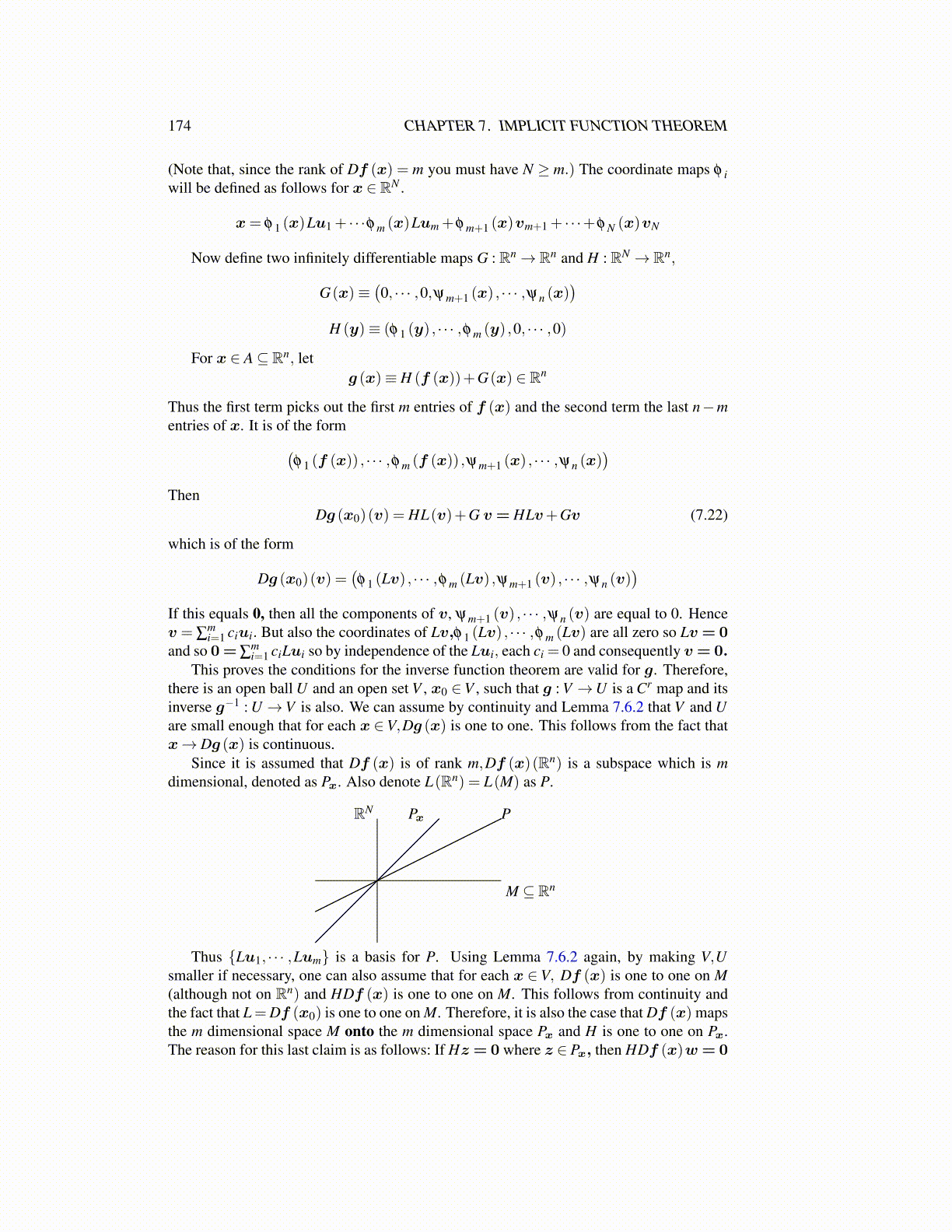
174 CHAPTER 7. IMPLICIT FUNCTION THEOREM
(Note that, since the rank of Df (x) = m you must have N ≥ m.) The coordinate maps φ iwill be defined as follows for x ∈ RN .
x= φ 1 (x)Lu1 + · · ·φ m (x)Lum +φ m+1 (x)vm+1 + · · ·+φ N (x)vN
Now define two infinitely differentiable maps G : Rn→ Rn and H : RN → Rn,
G(x)≡(0, · · · ,0,ψm+1 (x) , · · · ,ψn (x)
)H (y)≡ (φ 1 (y) , · · · ,φ m (y) ,0, · · · ,0)
For x ∈ A⊆ Rn, letg (x)≡ H (f (x))+G(x) ∈ Rn
Thus the first term picks out the first m entries of f (x) and the second term the last n−mentries of x. It is of the form(
φ 1 (f (x)) , · · · ,φ m (f (x)) ,ψm+1 (x) , · · · ,ψn (x))
ThenDg (x0)(v) = HL(v)+G v = HLv+Gv (7.22)
which is of the form
Dg (x0)(v) =(φ 1 (Lv) , · · · ,φ m (Lv) ,ψm+1 (v) , · · · ,ψn (v)
)If this equals 0, then all the components of v, ψm+1 (v) , · · · ,ψn (v) are equal to 0. Hencev = ∑
mi=1 ciui. But also the coordinates of Lv,φ 1 (Lv) , · · · ,φ m (Lv) are all zero so Lv = 0
and so 0 =∑mi=1 ciLui so by independence of the Lui, each ci = 0 and consequently v = 0.
This proves the conditions for the inverse function theorem are valid for g. Therefore,there is an open ball U and an open set V , x0 ∈V , such that g : V →U is a Cr map and itsinverse g−1 : U →V is also. We can assume by continuity and Lemma 7.6.2 that V and Uare small enough that for each x ∈V,Dg (x) is one to one. This follows from the fact thatx→ Dg (x) is continuous.
Since it is assumed that Df (x) is of rank m,Df (x)(Rn) is a subspace which is mdimensional, denoted as Px. Also denote L(Rn) = L(M) as P.
PPx
M ⊆ Rn
RN
Thus {Lu1, · · · ,Lum} is a basis for P. Using Lemma 7.6.2 again, by making V,Usmaller if necessary, one can also assume that for each x ∈ V, Df (x) is one to one on M(although not on Rn) and HDf (x) is one to one on M. This follows from continuity andthe fact that L =Df (x0) is one to one on M. Therefore, it is also the case that Df (x) mapsthe m dimensional space M onto the m dimensional space Px and H is one to one on Px.The reason for this last claim is as follows: If Hz = 0 where z ∈ Px, then HDf (x)w = 0